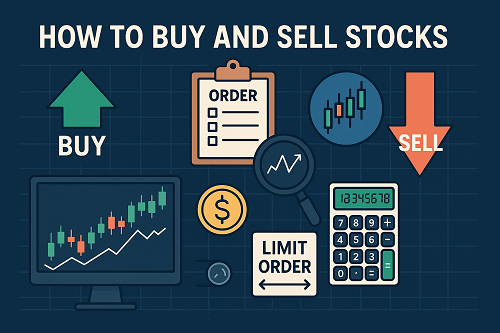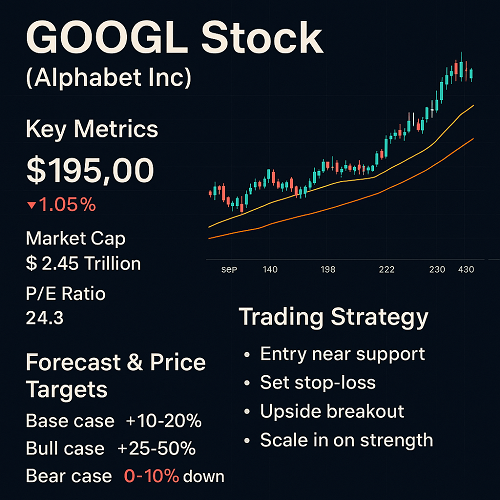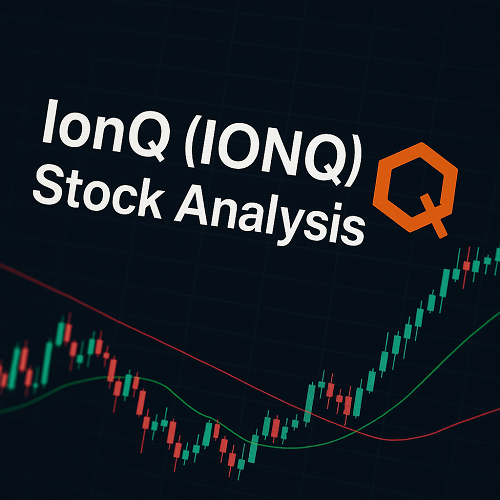Buying and selling stocks may seem straightforward on the surface — you pick a company, click “buy,” and hope the price moves your way. But behind that simplicity lies a lattice of decisions, tradeoffs, and mechanics. A well-executed trade depends not just on what you buy, but how, when, and where you do so.
The goal of this guide is to walk you step-by-step from zero to competence, equipping you with the knowledge to execute trades intelligently, manage costs, and avoid common pitfalls. You’ll emerge with the tools to conduct trading (or investing) in a disciplined, informed way.
Why Invest in Stocks?
Stocks represent fractional ownership in a company. Over time, with successful enterprises and economic growth, stocks have historically delivered higher returns than many other asset classes (though with higher volatility). Advantages:
- Growth potential: Equity exposure lets you benefit from capital appreciation.
- Dividends & income: Some stocks pay recurring dividends, adding yield.
- Liquidity & transparency: Unlike real estate, stocks trade on exchanges with pricing and volume visibility.
- Diversification & access: You can invest in a broad array of sectors, geographies, and themes.
Risks are equally real: market risk, company-specific risk, liquidity risk, and psychological biases. Skilled trading seeks to tilt the odds in your favor through edge, discipline, and risk control.
Prerequisites: Mindset, Capital & Risk Tolerance
Before placing your first trade:
- Define your objective: Are you trading short term (days/weeks) or investing long term?
- Know your capital: Only commit what you can afford to lose without emotional distress.
- Set your risk tolerance: What percentage of your capital are you willing to risk on one trade (commonly 1–3 %)?
- Plan your process: Use a trading plan; define your entry, stop, target, and exit logic ahead of time.
- Educate yourself: Technical vs fundamental analysis, market microstructure, trading psychology.
- Demo/trade small first: Consider paper trading or very small sizes to validate your process.
Choosing the Right Account & Brokerage
Cash vs Margin Accounts
- Cash account: You can only trade with funds you own. No leverage. Low risk of forced liquidation.
- Margin account: You borrow from the broker to magnify returns. Requires margin agreement. Amplifies both gains and losses; potential for margin calls.
Registered vs Non-Registered Accounts (Canada / Local Context)
In Canada, many investors use RRSPs, TFSAs, RESPs for tax advantages; these generally must be cash accounts (i.e. no margin). Understand any restrictions on equities. For U.S. or other locales, consider IRAs, 401(k)s or taxable brokerage accounts.
Broker Types: Full-service, Discount, Robo
- Full-service: Offers advice, research support, wealth management. High commissions.
- Discount / online brokerage: Lower cost, self-directed, minimal service.
- Robo / hybrid: Algorithmic or low-touch advisors; decent for passive strategies.
When selecting a brokerage, evaluate:
- Commission structure
- Platform capabilities (charting, order types)
- Reliability and execution quality
- Access to markets, currencies, derivatives
- Customer service, regulatory compliance, security
- Margin rates, funding options
How to Place an Order — Order Types & Variations
When placing a buy or sell order, selecting the right order type is critical to execution control. Here is an overview:
Market Orders
Executes immediately at the best available price. Fast, but vulnerable to slippage in less liquid markets.
Limit Orders
You set a maximum (buy) or minimum (sell) threshold. Execution only if price touches that level. You control price but not certainty of fill.
Stop / Stop-Limit / Stop-Loss Orders
- Stop (market): Once a trigger price is hit, executes as a market order.
- Stop-limit: Once triggered, becomes a limit order (with your set limit).
- Stop-loss: Designed to cut losses; typically placed below your purchase price.
Trailing Stops
Dynamic stop orders that move with price. E.g. a 5% trailing stop moves up as the stock moves upward, locking in profits.
Conditional & Special Orders
- All-or-none (AON): Execute entire quantity or none.
- Fill-or-kill (FOK): Execute immediately in full or cancel.
- Iceberg / Hidden orders: Only a portion of order is visible in the order book.
- Good-til-cancelled (GTC), Day, Good-til-date (GTD): Time-in-force instructions.
Execution Mechanics & Market Structure
Understanding how the market operates behind the scenes helps you place smarter trades.
Order Routing & Liquidity Providers
When you click “Buy,” your broker routes the order—possibly via exchanges, market makers, or dark pools. Optimal routing matters for speed, price, and execution quality.
Bid-Ask Spread & Slippage
Every quote has a bid (price someone is willing to buy) and ask (price someone is willing to sell). Your order may cross the spread, causing cost. In volatile markets, slippage can degrade your outcome.
Partial Fills
In large orders or thin markets, only part may execute. Be ready to manage remaining portions or cancel.
Impact Cost & Market Impact
Placing large orders can move the market against you. If your size is a significant portion of average daily volume, fragment your order or use algorithms.
Advanced Strategies & Techniques
Dollar-Cost Averaging (DCA)
Buy a fixed dollar amount at set intervals, regardless of price. Reduces timing risk. Simpler for long-term investors.
Buying on Margin / Leverage
Using borrowed money magnifies returns and losses. You also pay interest and face margin calls if positions move against you.
Short Selling
You borrow shares to sell them, hoping to buy them back cheaper. Unlimited risk (price can rise indefinitely). Needs margin and careful monitoring.
Hedging via Options (Intro)
Options (calls, puts, spreads) let you protect or leverage positions. E.g. buying a put can serve as insurance. (Note: options demand their own deep guide.)
Algorithmic / Automated Strategies
Scripts or bots execute based on predefined rules — e.g. price thresholds, volume spikes, or statistical arbitrage.
Smart Order Routing / Execution Algorithms
Large brokers or algos may slice your order, randomize execution intervals, and direct them to different venues to achieve better average prices.
Costs, Fees & Impacts
Explicit Costs
- Commissions: Flat or per-share fees.
- Platform fees: Monthly subscription, data feed charges.
- Inactivity or account maintenance fees.
Implicit / Hidden Costs
- Bid-ask spread: The “cost” you pay by crossing the spread.
- Slippage: Difference between expected price and execution price.
- Market impact: Your order causes price movement.
- Opportunity cost: Capital tied up that could be earning elsewhere.
Taxes & Regulations
- Capital gains tax (on profits), dividend tax, withholding on foreign stocks.
- Wash-sale rules (especially in the U.S.) disallow tax loss harvesting if you re-buy too soon.
- Reporting obligations in tax jurisdictions.
The Erosion Effect of Cost
Frequent trading magnifies cost erosion. Imagine 1% returns repeatedly chipped away by commissions and slippage — your net outcome may become negative.
Key Metrics & Tools for Order Planning
Volume & Liquidity Measures
Look at average daily volume (ADV), volume spikes, and order book depth.
Volatility Indicators
- ATR (Average True Range)
- Implied vs historical volatility
- Bollinger Bands, Keltner Channels
Relative Price Indicators
- VWAP (Volume-Weighted Average Price)
- Moving averages (20, 50, 200-day)
- Price divergence, momentum (RSI, MACD)
Sizing & Execution Considerations
Trade size relative to liquidity — avoid placing 20% of ADV in one go. Use time-based triggers (e.g., only enters after 9:45 am) or volume filters to avoid early volatility.
Post-Trade: Settlement, Confirmation & Record-Keeping
Trade Confirmation & Clearing
You’ll receive a trade confirmation detailing symbol, quantity, price, commissions. Trades are cleared via clearinghouses (e.g. Canada’s CDS, U.S. clearing). Settlement periods (often T+1 or T+2) apply.
Corporate Actions
Be aware of dividends, stock splits, mergers, spin-offs. These can affect your holdings, basis, and tax treatment.
Stock Certificates & Dematerialization
Modern markets often eliminate paper certificates — shares are held electronically. If you still hold paper certificates, ensure they’re registered with transfer agents.
Record-Keeping & Portfolio Tracking
Maintain logs of your trades (entry, exits, rationale). Compute metrics like Win Rate, Risk/Reward, Sharpe Ratio. Use tools or spreadsheets or platforms offering analytics.
Best Practices & Risk Management
- Position sizing: risk only a small % of capital per trade (1–3 %)
- Use stop-loss / trailing stop to limit loss
- Avoid emotional trading — stick to your plan
- Use liquidity and exit planning before entering
- Limit simultaneous exposure (don’t over-leverage correlations)
- Avoid overtrading — more trades doesn’t mean more profit
- Review past trades regularly, learn continuously
How to Handle Unusual Scenarios
Circuit Breakers & Trading Halts
Markets may pause when volatility is extreme. Orders may not execute or may queue.
Flash Crashes
Brief, deep price drops (often milliseconds). Watch for liquidity evaporation and widen spreads.
Mergers, Delistings & Reorganizations
Your position may be converted, redeemed, or exchanged. Know your rights and options.
Stock Splits & Reverse Splits
Your share count and price adjust; total value remains. Adjust cost basis accordingly.
Spin-offs & Recapitalizations
You may receive shares in a new entity. Understand tax implications and timeline.
Example Walkthroughs
Example 1: Growth Stock Trade
- Entry: ABC at $50
- Target: $60 (20 % gain)
- Stop-loss: $47 (6 % risk)
- Order: Limit buy, trailing stop once target reached
- Execution: Partial fills, manage slippage
- Exit: Trailing stop triggered at $59
Analysis: Reward-to-risk ~3.3×; mid-trade adjustments based on volatility.
Example 2: Dividend Trader
- Entry: XYZ at $40 paying 4 % annually
- Use limit order
- Avoid ex-dividend date timing risk
- Adjust stop-loss considering dividend ex-date
Lessons: Be careful about dividend capture vs share price drop.
Example 3: A Mistake & Lesson
- Bought large position in thin stock
- No stop-loss set
- Price collapsed due to news
- Unable to exit early — forced at deep loss
Lesson: Always plan exit before entry; manage liquidity and risk.
Summary & Key Takeaways
- Buying and selling stocks isn’t just pressing a button — it’s about strategy, discipline, and execution.
- Choose your account, brokerage, and tools carefully.
- Master order types and execution dynamics.
- Always manage costs, slippage, and taxes.
- Use risk controls, plan your exit, limit position size, and avoid overtrading.
- Maintain a trade journal and continuously refine your process.
Frequently Asked Questions (FAQs)
Q: Can I really place trades via phone or in person?
Yes — many full-service brokers still allow that. But online execution is faster, cheaper, and gives full control.
Q: Is there a minimum number of shares I must buy?
Depends on the broker and stock. Some require minimums; others allow fractional shares (if supported).
Q: Should I always use a limit order?
Limit orders control price but may not fill. Market orders guarantee fill but give up control over execution price. Use wisely based on liquidity.
Q: What happens if my order doesn’t fill by end-of-day?
If your order is “Day” time-in-force, it cancels. If “GTC” or “GTD,” it remains open until filled or expiration.
Q: How do I choose the right stop-loss?
Use volatility-based metrics (e.g. ATR), chart support zones, or percentage rules. Avoid arbitrary stops that can trigger prematurely.
Q: Can I avoid taxes?
You can optimize tax planning (e.g. using registered accounts), but avoid illegal tax evasion. Consult a tax professional for your jurisdiction.





 XAUT-USD
XAUT-USD  AMD
AMD  MARA
MARA  SHOP
SHOP  BULL
BULL  CL=F
CL=F